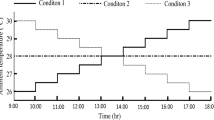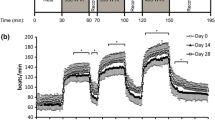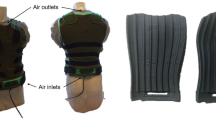Abstract
Humans have higher ventilation when they are hyperthermic but it is not known whether core temperature thresholds for ventilation exist, nor has a physiological rationale been presented for this response. To examine this question, ventilation was studied in relation to core temperatures in humans rendered hyperthermic in a warm bath. Seven subjects [mean (SE), 23.3 (1.4) years] wearing only shorts and a thick felt hat with ear flaps were immersed to the neck in a bath at 41 (0.5)°C for 25 min. Tympanic (T ty), esophageal (T es), thigh skin and forehead skin temperatures, heart rate, inspired minute ventilation (V I at body temperature and pressure, saturated), ventilation frequency and oxygen consumption (VO2 at standard temperature and pressure, dry) were recorded at 30-s intervals. At immersion V I briefly increased to 18.6 (3.0)l·min−1 returned to about the pre-immersion value,, and significantly increased to 19.3 (3.0) l·min−1 by the end of immersion. VO2 increased significantly from the pre-immersion value of 0.27 l·min−1 to 0.67 l·min−1 by the first 0.5 min of immersion, but then returned to its pre-immersion value. T ty increased to 38.7 (0.2)°C and T es increased to 39.0 (0.2)°C by the end of immersion. Core temperature thresholds for increases in V I were evident at 38.1°C when expressed against T ty and at 38.5°C when expressed against T es. The results indicated that during body warming core temperature thresholds for V I are reached and subsequently a hyperpnea was evident, despite VO2 remaining at a resting value. This hyperpnea is seen as a thermoregulatory response likely to participate in selective brain cooling.
Similar content being viewed by others
References
Baker MA (1982) Brain cooling in endotherms in heat and exercise. Ann Rev Physiol 44:85–96
Bazett HC, Haldane JBS (1921) Some effects of hot baths on man. J PHysiol (Lond) 55:4–5
Brinnel H, Cabanac M (1989) Tympanic temperature is a core temperature in humans. J Thermal Biol 14:47–53
Cabanac M (1993) Selective brain cooling in humans: “fancy” or fact? FASEB J 7:1143–47
Cabanac M, Brinnel H (1985) Blood flow in the emissary veins of the human head during hyperthermia. Eur J Appl Physiol 54:172–176
Cabanac M, Caputa M (1979) Open loop increase in trunk temperature produced by face cooling in humans. J Physiol (Lond) 289:163–174
Caputa M, Perrin G, Cabanac M (1978) Écoulement sanguin réversible dans la veine ophtalmique: mécanisme de refroidissment sélectif du cerveau humain. C R Acad Sci Paris 287:1011–1014
Cunningham DJC, O'Riordan JHL (1957) The effect of a rise in the temperature of the body on the respiratory response to carbon dioxide. Q J Exp Biol 42:329–345
Dejours P (1963) Respiration. In: Kayser C (ed) Physiologic, vol III. Les grandes fonctions. Flammarion, Paris, pp 7–246
Deklunder G, Dauzat M, Lecroart J-L, Hauser J-J, Houdas Y (1991) Influence of ventilation of the face on thermoregulation in man during hyper- and hypothermia. Eur J Appl Physiol 62:342–348
Dmi'el R (1986) Selective sweat secretion and panting modulation in dehydrated goats. J Thermal Biol 11:157–159
Gaudio R Jr, Abramson N (1968) Heat-induced hyperventilation. J Appl Physiol 25:742–746
Haldane JS (1905) The influence of high air temperatures. J Hyg 55:497–513
Hales JRS, Dampney RAL (1975) The redistribution of cardiac output in the dog during heat stress. J Thermal Biol 1:29–34
Hanson R (1974) Respiratory heat loss at increased core temperature. J Appl Physiol 37:103–107
Hirashita M, Shido O, Tanabe M (1992) Blood flow through the opthalmic veins during exercise in humans. Eur J Appl Physiol 64:92–97
House JR, Holmes C (1992) Respiratory responses of hyperthermic subjects. In: Lotens WA, Navenitha (eds) Environmental ergonomics proceedings of the 5th International Congress of Environmental Ergonomics. TNO Press, Soesterberg, The Netherlands pp 210–211
IUPS Commission on Thermal Physiology (1987) Glossary of terms for thermal physiology. Pflügers Arch 410:567–587
Khogali M (1987) Heat stroke: an overview with particular reference to the Makkah pilgrimage. In: Hales JRS, Richards DAB (eds) Heat stress, physical exertion and the environment. Elsevier, Amsterdam, pp 21–36
Mariak Z, Lewko J, Luczaj J, Polocki B, White M (1994) Relationship between directly measured human cerebral and tympanic temperatures during changes of brain temperatures. Eur J Appl Physiol 69:545–549
Maskrey M (1984) Metabolic and acid-base implications of thermal panting. In: Hales JRS (ed) Thermal physiology, Raven, New York, pp 347–352
McConaghy FF, Hales JRS, Hodgson DR (1994) Selective brain cooling in the horse during exercise. In: Milton AS (ed) Temperature regulation: recent physiological and pharmaceutical advances Birkhäuser, Basel, pp 189–193
Mekjavic IB, Bligh J (1989) Increased oxygen uptake upon immersion. Eur J Appl Physiol 58:556–562
Mekjavic IB, Rempel ME (1990) Determination of esophageal probe insertion length based on standing and sitting height. J Appl Physiol 69:376–379
Mitchell D, Laburn HP, Nijland MJM, Zurovsky Y, Mitchell G (1987) Selective brain cooling and survival. S Afr J Sci 83:598–604
Nagasaka T, Brinnel H, Hirata K, Noda Y, Sugimoto N (1989) Increase in venous flow through opthalamic veins enhances selective brain cooling in hyperthermic humans. In: Mercer JB (ed) Thermal physiology. Elsevier, Amsterdam, pp 205–210
Pleschka K, Kuhn P, Nagai M (1992) Differential vasomotor adjustments in the evaporative tissues of the tongue and nose in the dog under heat load. Pflügers Arch 340:71–76
Rasch W, Cabanac M (1993) Selective brain cooling is affected by wearing headgear during exercise. J Appl Physiol 74:1229–1233
Rasch W, Samson P, Coté J, Cabanac M (1991) Heat loss from the human head during exercise. J Appl Physiol 71:590–595
Robertshaw D, Dmi'el R (1986) The effect of dehydration on the control of panting and sweating in the black Bodouin goat. J Physiol Zool 56:412–418
Saxton C (1981) Effects of severe heat stress on respiration and metabolic rate in resting man. Aviat Space Environ Med 52:281–286
Shiraki K, Sagawa S, Tajima F, Yokota A, Hashimoto M, Brengelmann GL (1988) Independence of brain and tympanic temperatures in an unanesthetized human. J Appl Physiol 65:482–486
Walpoth BH, Galdikas J, Leupi F, Meuhlemann W, Schlaepfer P, Althaus U (1994) Assessment of hypothermia with a new “tympanic” thermometer. J Clin Monit 10:91–96
West JB (1983) Control of ventilation. In: Respiratory physiologythe essentials, 2nd edn., Williams and Wilkins, Baltimore, pp 114–126
White MD, Cabanac M (1993) Exercise hyperpnea and selective brain cooling in humans (abstract). FASEB J 7:A16
White MD, Cabanac M (1995) Nasal mucosal vasodilatation in response to passive hyperthermia in humans. Eur J Appl Physiol 70:207–212
Author information
Authors and Affiliations
Rights and permissions
About this article
Cite this article
Cabanac, M., White, M.D. Core temperature thresholds for hyperpnea during passive hyperthermia in humans. Europ. J. Appl. Physiol. 71, 71–76 (1995). https://doi.org/10.1007/BF00511235
Accepted:
Issue Date:
DOI: https://doi.org/10.1007/BF00511235




